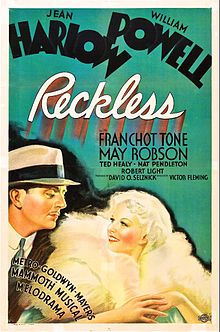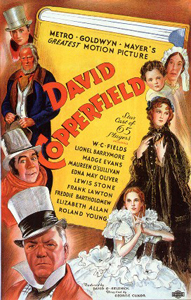
David Copperfield is a 1935 American film released by Metro-Goldwyn-Mayer based upon Charles Dickens' 1850 novel The Personal History, Adventures, Experience, & Observation of David Copperfield the Younger.

A Tale of Two Cities is a 1935 film based upon Charles Dickens' 1859 historical novel, A Tale of Two Cities, set in London and Paris. The film stars Ronald Colman as Sydney Carton and Elizabeth Allan as Lucie Manette. The supporting players include Edna May Oliver, Reginald Owen, Basil Rathbone, Lucille La Verne, Blanche Yurka, Henry B. Walthall and Donald Woods. It was directed by Jack Conway from a screenplay by W. P. Lipscomb and S. N. Behrman. The film was nominated for the Academy Award for Best Picture and Best Film Editing.
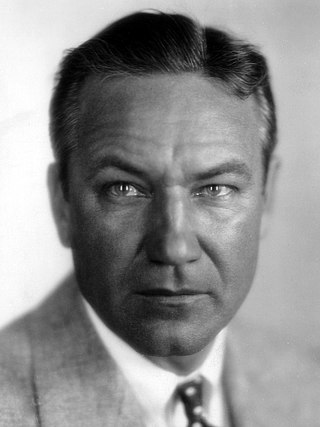
Victor Lonzo Fleming was an American film director, cinematographer, and producer. His most popular films were Gone with the Wind, for which he won an Academy Award for Best Director, and The Wizard of Oz. Fleming has those same two films listed in the top 10 of the American Film Institute's 2007 AFI's 100 Years...100 Movies list.

Jean Harlow was an American actress. Known for her portrayal of "bad girl" characters, she was the leading sex symbol of the early 1930s and one of the defining figures of the pre-Code era of American cinema. Often nicknamed the "Blonde Bombshell" and the "Platinum Blonde", Harlow was popular for her "Laughing Vamp" screen persona. Harlow was in the film industry for only nine years, but she became one of Hollywood's biggest movie stars, whose image in the public eye has endured. In 1999, the American Film Institute ranked Harlow number 22 on its greatest female screen legends of classical Hollywood cinema list.

Rhett Butler is a fictional character in the 1936 novel Gone with the Wind by Margaret Mitchell and in the 1939 film adaptation of the same name. It is one of Clark Gable's most recognizable and significant roles.

Little Women is a 1949 American comedy-drama film with script and music taken directly from the earlier 1933 Hepburn version. Based on Louisa May Alcott's 1868–69 two-volume novel of the same name, it was filmed in Technicolor and was produced and directed by Mervyn LeRoy. The screenplay was written by Sally Benson, Victor Heerman, Sarah Y. Mason, and Andrew Solt. The original music score was composed by Adolph Deutsch and Max Steiner. The film also marked the American film debut of Italian actor Rossano Brazzi. Sir C. Aubrey Smith, whose acting career had spanned four decades, died in 1948; Little Women was his final film.

Dinner at Eight is a 1933 American pre-Code comedy-drama film directed by George Cukor from a screenplay by Frances Marion and Herman J. Mankiewicz, based on George S. Kaufman and Edna Ferber's 1932 play of the same title. The film features an ensemble cast of Marie Dressler, John Barrymore, Wallace Beery, Jean Harlow, Lionel Barrymore, Lee Tracy, Edmund Lowe, and Billie Burke.

Barbary Coast is a 1935 American historical Western film directed by Howard Hawks. Shot in black-and-white and set in San Francisco's so-called Barbary Coast during the California Gold Rush, the film combines elements of the Western genre with those of crime, melodrama and adventure. It features a wide range of actors, from hero Joel McCrea to villain Edward G. Robinson, and stars Miriam Hopkins in the leading role as Mary 'Swan' Rutledge. In an early, uncredited appearance, David Niven plays a drunken sailor being thrown out of a bar.

Small Town Girl is a 1936 American romantic comedy film directed by William A. Wellman and starring Janet Gaynor, Robert Taylor, and James Stewart. The supporting cast features Binnie Barnes, Andy Devine, Lewis Stone and Edgar Kennedy.

Suzy is a 1936 American drama film directed by George Fitzmaurice and starring Jean Harlow, Franchot Tone and Cary Grant. The film was partially written by Dorothy Parker, based on a novel by Herbert Gorman. The Academy Award-nominated theme for Suzy, "Did I Remember?", was sung by Virginia Verrill (uncredited).

The Scarlet Pimpernel is a 1934 British adventure film directed by Harold Young and starring Leslie Howard, Merle Oberon, and Raymond Massey. Based on the 1905 play by Baroness Orczy and Montagu Barstow and the classic 1905 adventure novel by Orczy, the film is about an eighteenth-century English aristocrat (Howard) who leads a double life, passing himself off as an effete aristocrat while engaged in a secret effort to rescue French nobles from Robespierre's Reign of Terror. The film was produced by Alexander Korda. Howard's portrayal of the title character is often considered the definitive portrayal of the role. In 1941, he played a similar role in "'Pimpernel' Smith" but this time set in pre-WWII Germany.

Harold G. "Hal" Rosson, A.S.C. was an American cinematographer who worked during the early and classical Hollywood cinema, in a career spanning some 52 years, starting from the silent era in 1915. He is best known for his work on the fantasy film The Wizard of Oz (1939) and the musical Singin' in the Rain (1952), as well as his marriage to Jean Harlow.

William Horatio Powell was an American actor, known primarily for his film career. Under contract with Metro-Goldwyn-Mayer, he was paired with Myrna Loy in 14 films, including the Thin Man series based on the Nick and Nora Charles characters created by Dashiell Hammett. Powell was nominated for the Academy Award for Best Actor three times: for The Thin Man (1934), My Man Godfrey (1936), and Life with Father (1947).

Little Lord Fauntleroy is a 1936 American drama film based on the 1886 novel of the same name by Frances Hodgson Burnett. The film stars Freddie Bartholomew, Dolores Costello, and C. Aubrey Smith. The first film produced by David O. Selznick's Selznick International Pictures, it was the studio's most profitable film until Gone with the Wind. The film is directed by John Cromwell.
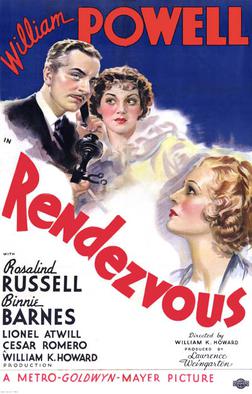
Rendezvous is a 1935 American spy film set in World War I, directed by William K. Howard, starring William Powell and Rosalind Russell and featuring Binnie Barnes, Lionel Atwill, Cesar Romero and Samuel S. Hinds. Powell plays an American cryptologist who tangles with German spies while falling in love.
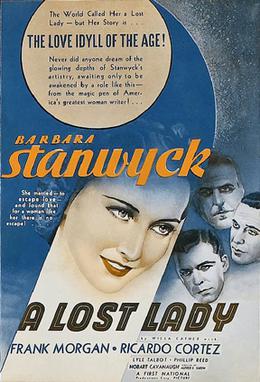
A Lost Lady is a 1934 American drama film directed by Alfred E. Green and starring Barbara Stanwyck, Frank Morgan, and Ricardo Cortez. Based on the 1923 novel A Lost Lady by Willa Cather, with a screenplay by Gene Markey and Kathryn Scola, the film is about a woman whose fiancé is murdered by his mistress' husband two days before their wedding. Her uncle sends her away to the mountains, where she meets a man who looks after her and eventually proposes. She accepts even though she does not love him.
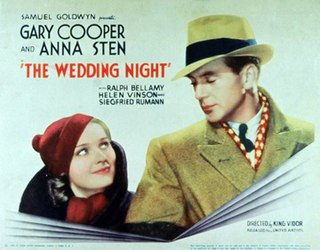
The Wedding Night is a 1935 American romantic drama film directed by King Vidor and starring Gary Cooper and Anna Sten. Written by Edith Fitzgerald and based on a story by Edwin H. Knopf, the film is about a financially strapped novelist who returns to his country home in Connecticut looking for inspiration for his next novel and becomes involved with a beautiful young Polish woman and her family. The film was produced by Samuel Goldwyn and filmed at Samuel Goldwyn Studios from early November to early December 1934. It was released in the United States on March 8, 1935.

Star of Midnight is a 1935 American mystery comedy film directed by Stephen Roberts. William Powell was loaned to RKO Pictures from MGM to star with Ginger Rogers.

The Casino Murder Case is a 1935 American mystery film starring Paul Lukas and Alison Skipworth. Rosalind Russell is in the supporting cast. It was directed by Edwin L. Marin from a screenplay by Florence Ryerson and Edgar Allan Woolf, based on the 1934 novel of the same name by S. S. Van Dine. It was the ninth film in the Philo Vance film series.

Catherine Virginia Verrill was a singer in the era of old-time radio and big bands. Her work included providing the off-screen singing voices for some female film stars.
